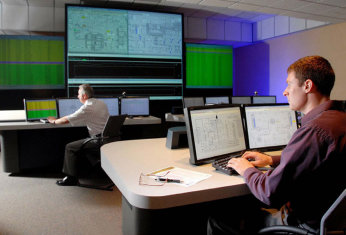Background
Westinghouse has developed a modular approach to designing custom main control rooms (MCRs) as part of an instrumentation and control (I&C) system modernization program for new plant designs. The MCR modernization program comprises the human systems interface (HSI) building blocks to modernize an MCR, as well as the integration of standard, software-based HSI resources using the building-block approach. Examples of MCR configurations are based on this approach, which supports new plant construction and existing plant modernizations.
Description

Example of a modern, primarily soft MCR
MCR hardware building blocks:
- Operator control consoles
- Large display panel (LDP)
- Safety-related HSI (integrated in the operator’s console or in a separate safety console)
Nonsafety-related HSI building blocks:
- Distributed control system (DCS) workstations, featuring two full-functional flat panel displays (FPDs), usually measuring 20 inches diagonally
- An LDP driven by the DCS installed in front of all MCR operator consoles, consisting of 50- to 67-inch FPDs
- All MCR nonsafety-related building blocks seismic category II devices, which provide for structural integrity during seismic events
- Safety-related HSI building blocks:
- A Common Q FPD system, qualified to U.S. Nuclear Regulatory Commission (NRC) Class 1E criteria for equipment and software, utilizing channelized operators’ modules for the protection system, multi-channel control, monitoring; and channelized maintenance and test for use outside the MCR
- Soft control confirmation switches used with soft control commands issued to safety components from the DCS or Common Q FPDs
- A safety panel, consisting of two Class 1E, multi-channel Common Q FPDs for display; safety controls with one-step access to NRC Regulatory Guide 1.97, Category 1 parameters; one set of soft control confirmation switches; and two channelized, fixed-position pushbuttons for reactor trip and the actuation of each engineered safety feature (ESF)
- A “Position 4” panel to address NUREG-0800 HCIB BTP-19 provides switches for diverse system-level ESF actuation and its accompanying display integration of HSI resources and building blocks. HSI building blocks are effective when integrated through software with the functional designs of HSI resources. There are four principal HSI resources: soft controls, computerized procedures system (CPS), displays and alarms.
Benefits
- Modular HMI approach accommodates a diverse set of potential MCR customers.
- Different licensing criteria, philosophies and operating standards are addressed, as well as plant designs and vintages.
- The focus is on re-using HSI building blocks and only customizing software when it necessary.
- The modular approach allows the same set of HSI equipment to be used for new construction as well as plant modernizations.
- Economic benefits are realized via minimization of the amount of HSI equipment in the MCR, standardization of equipment used, and reduction of initial capital investment.
- Other economic benefits result from reduced long-term equipment maintenance costs over the duration of plant life.
Experience
Westinghouse has constructed a compact control room development and test facility to enhance existing HSI resource designs and integrate the HSI resources into a primarily soft environment. Westinghouse has completed nine main control room modernization projects.


